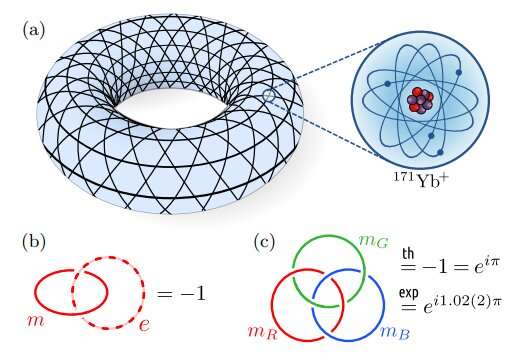May 10, 2023 report
Nonabelions observed in quantum computer could make them less prone to errors

Bob Yirka
news contributor

In a development that could make quantum computers less prone to errors, a team of physicists from Quantinuum, California Institute of Technology and Harvard University has created a signature of non-Abelian anyons (nonabelions) in a special type of quantum computer. The team has published their results on the arXiv preprint server.
As scientists work to design and build a truly useful quantum computer, one of the difficulties is trying to account for errors that creep in. In this new effort, the researchers have looked to anyons for help.
Anyons are quasiparticles that exist in two dimensions. They are not true particles, but instead exist as vibrations that act like particles—certain groups of them are called nonabelions. Prior research has found that nonabelions have a unique and useful property—they remember some of their own history. This property makes them potentially useful for creating less error-prone quantum computers. But creating, manipulating and doing useful things with them in a quantum computer is challenging. In this new work, the team have come close by creating a physical simulation of nonabelions in action.
The research involved building a quantum computer based on a chip that produces electric fields that can trap ytterbium ions, which are then used to represent qubits. In their design, the trapped ions could be moved around, allowing them to interact if desired. They used this characteristic to entangle 32 ions in a lattice in the form of a kagome, all of which shared the same quantum state. Additional manipulation put the kagome in an excited state that allowed for simulating particles with properties of nonabelions.
The team then tested their machine to ensure the simulated nonabelions performed just as real ones would do under the same conditions—one such test involved moving the nonabelions to create Borromean rings—and that, the team suggests, showed that they might be used to overcome the need for much of the error correction normally involved in quantum computers.
Written for you by our author —this article is the result of careful human work. We rely on readers like you to keep independent science journalism alive. If this reporting matters to you, please consider a (especially monthly). You'll get an ad-free account as a thank-you.
More information: Mohsin Iqbal et al, Creation of Non-Abelian Topological Order and Anyons on a Trapped-Ion Processor, arXiv (2023).
Journal information: arXiv
© 2023 Science X Network



















